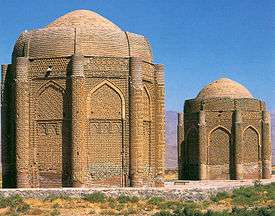Razi style
The "Razi style" (شیوه معماری رازی) is a style (sabk) of architecture when categorizing Iranian architecture development in history.[1][2]
The Dictionary of Traditional Iranian Architecture defines the Razi Style as:[3]
"A style of architecture dating from the 11th century to the Mongol invasion period, which includes the methods and devices of The Samanids, Ghaznavids, and Seljukids."
Examples
Examples of this style are Tomb of Isma'il of Samanid, Gonbad-e Qabus, Kharaqan towers.
-

Kharaqan towers: 1067CE
-

The Red Dome of Maragheh
See also
References
- ↑ Sabk Shenasi Mi'mari Irani (Study of styles in Iranian architecture), M. Karim Pirnia. 2005. ISBN 964-96113-2-0
- ↑ Siddiq-a-Akbar, Aptul Rakumāṉ, Muhammad Ali Tirmizi, Sultanate period architecture: proceedings of the Seminar on the Sultanate Period Architecture in Pakistan, held in Lahore, November 1990 , P 179
- ↑ Fallahfar, Saeed (سعید فلاحفر). Dictionary of Traditional Iranian Architecture (فرهنگ واژههای معماری سنتی ایران). Kamyab Publications. Edition 1. Tehran. 2000. ISBN 964-350-316-X pp.106 ((2nd print))
External links
- Encyclopedia Iranica on ancient Iranian architecture
- Encyclopedia Iranica on Stucco decorations in Iranian architecture
This article is issued from Wikipedia - version of the 1/27/2016. The text is available under the Creative Commons Attribution/Share Alike but additional terms may apply for the media files.

